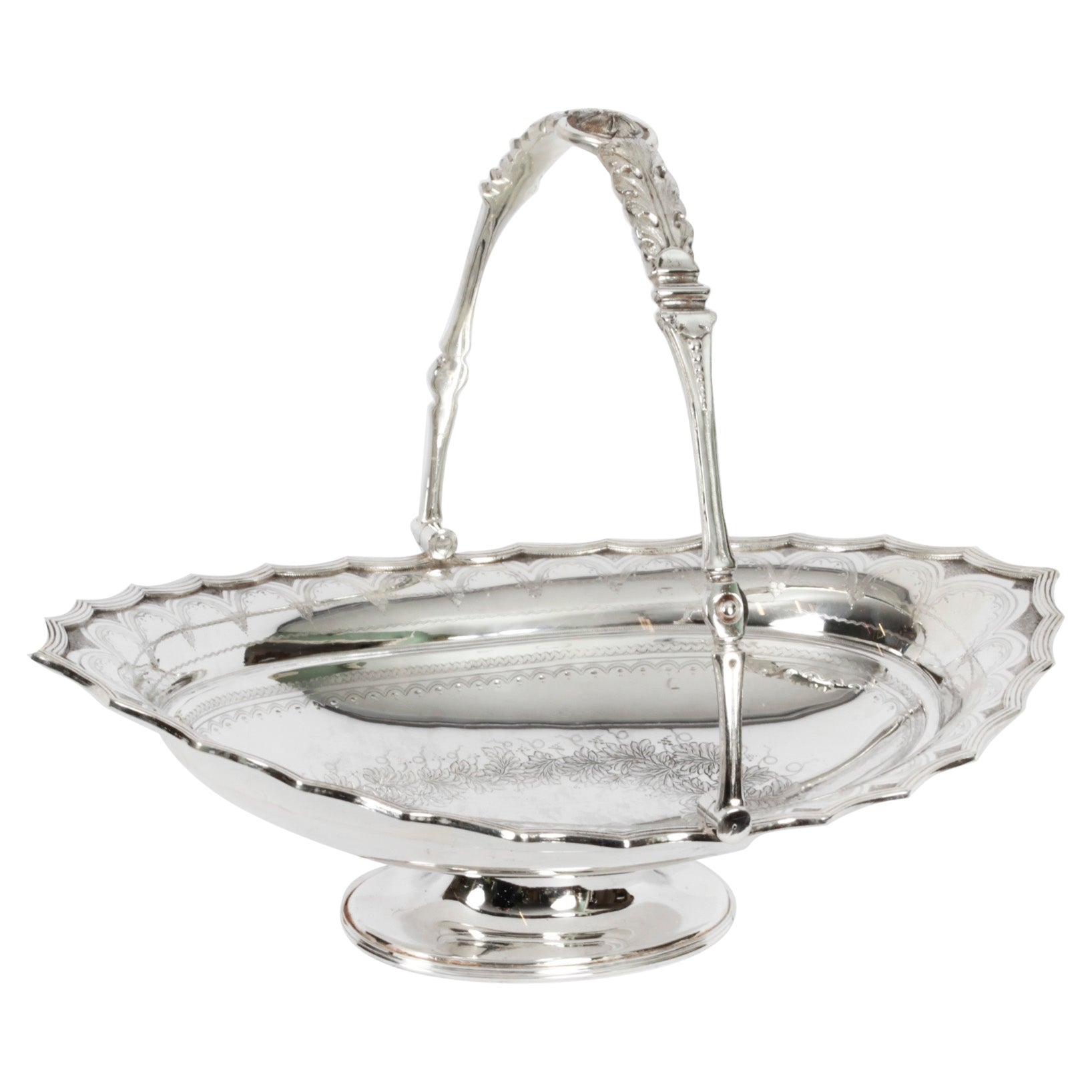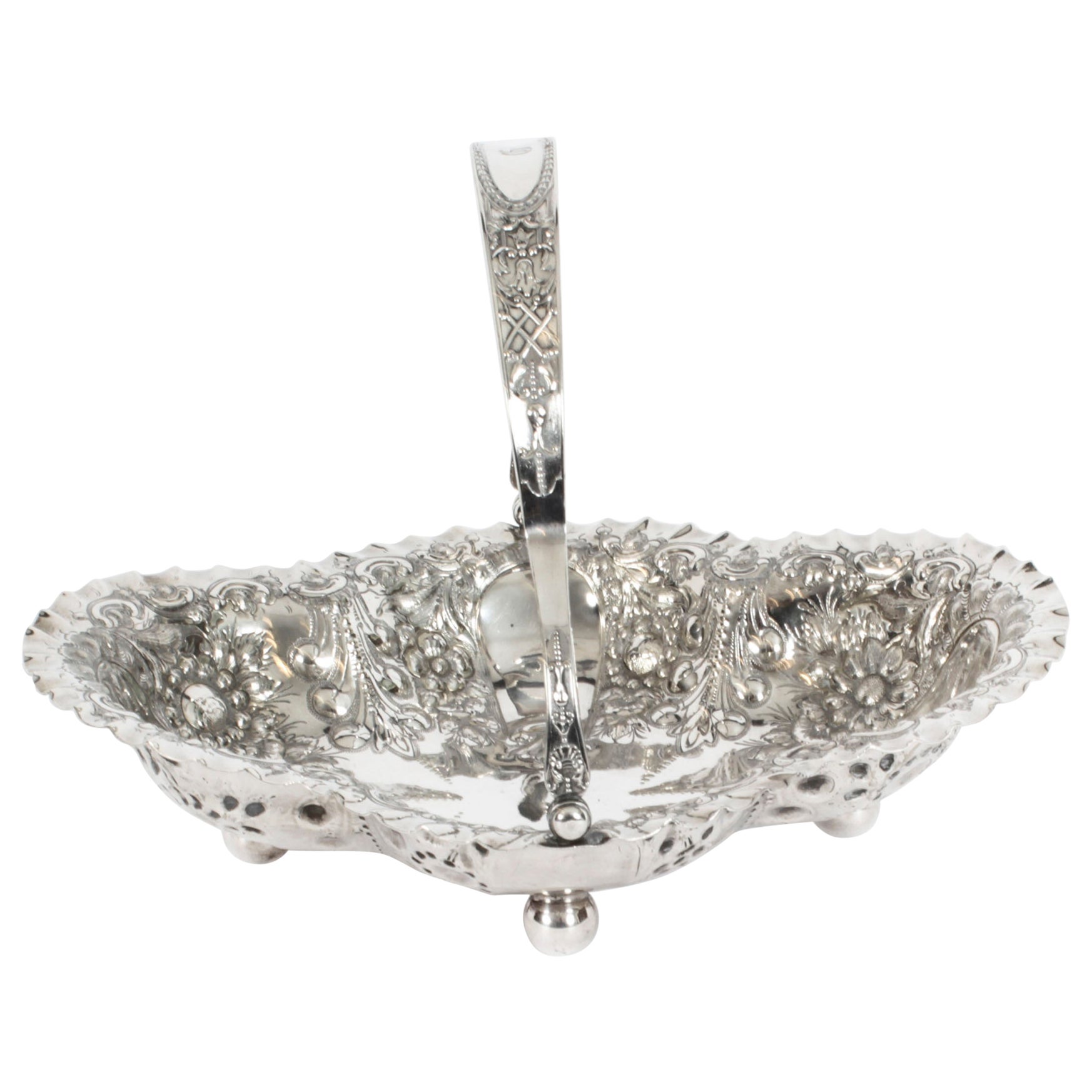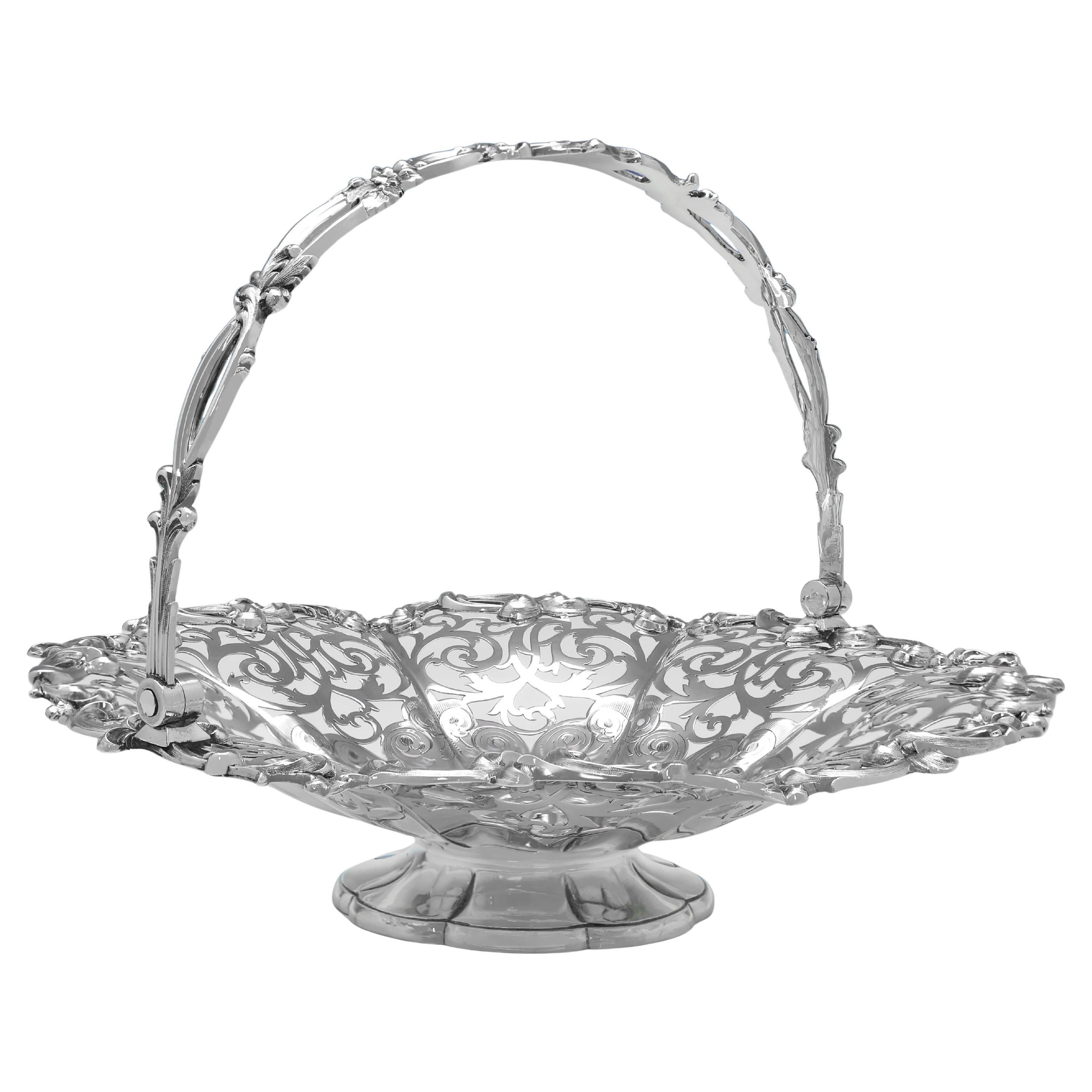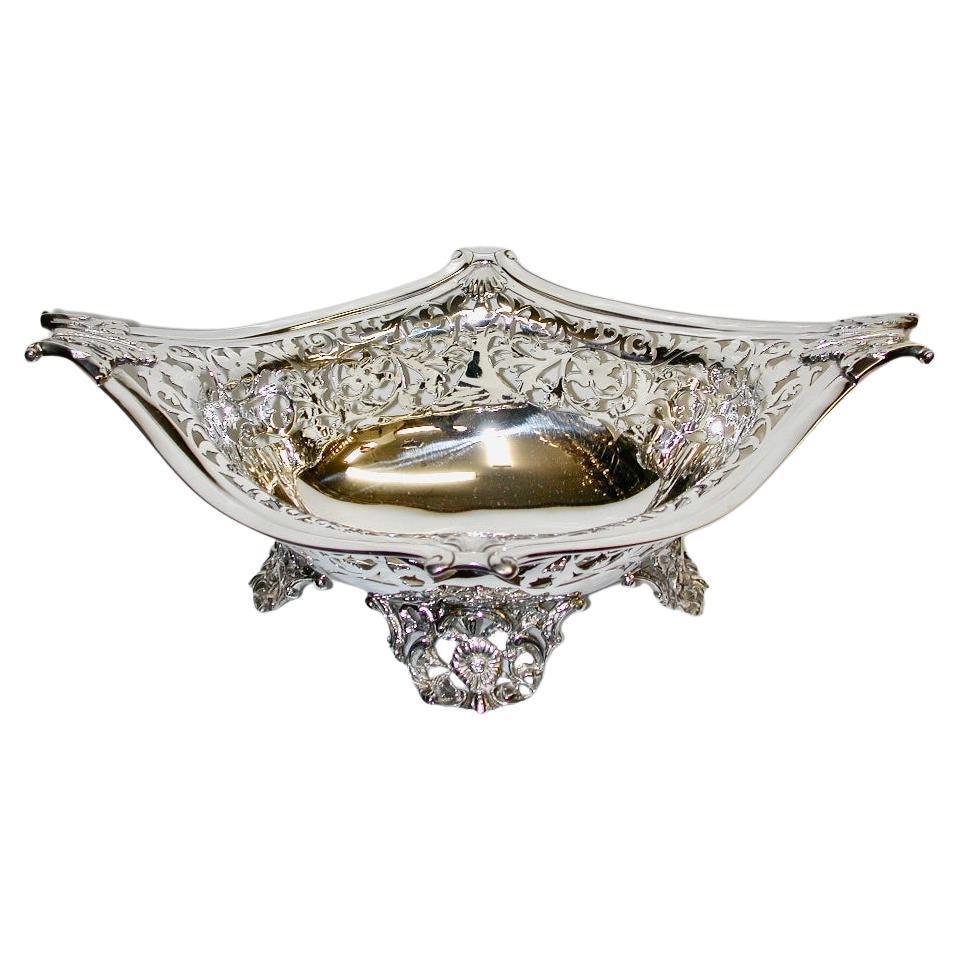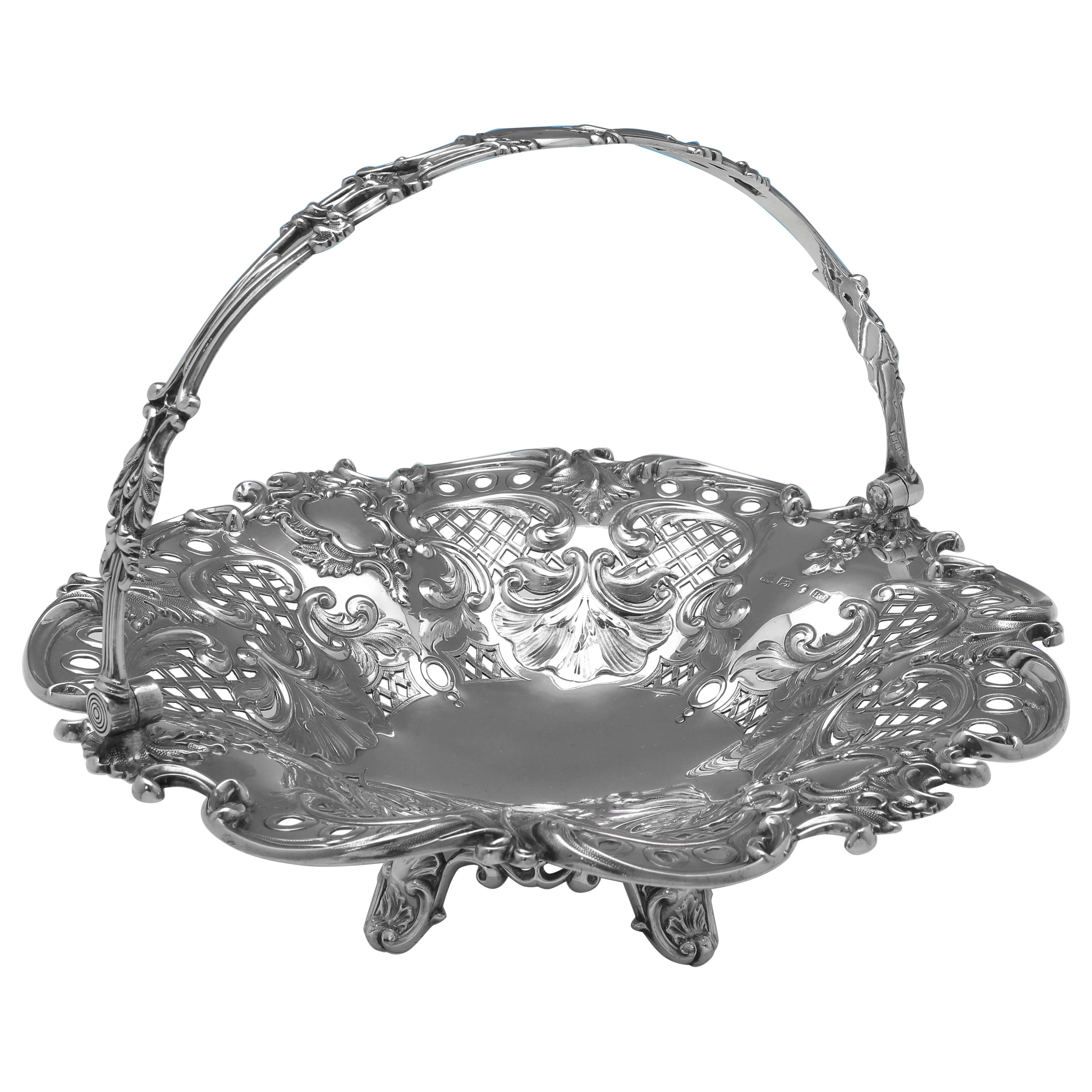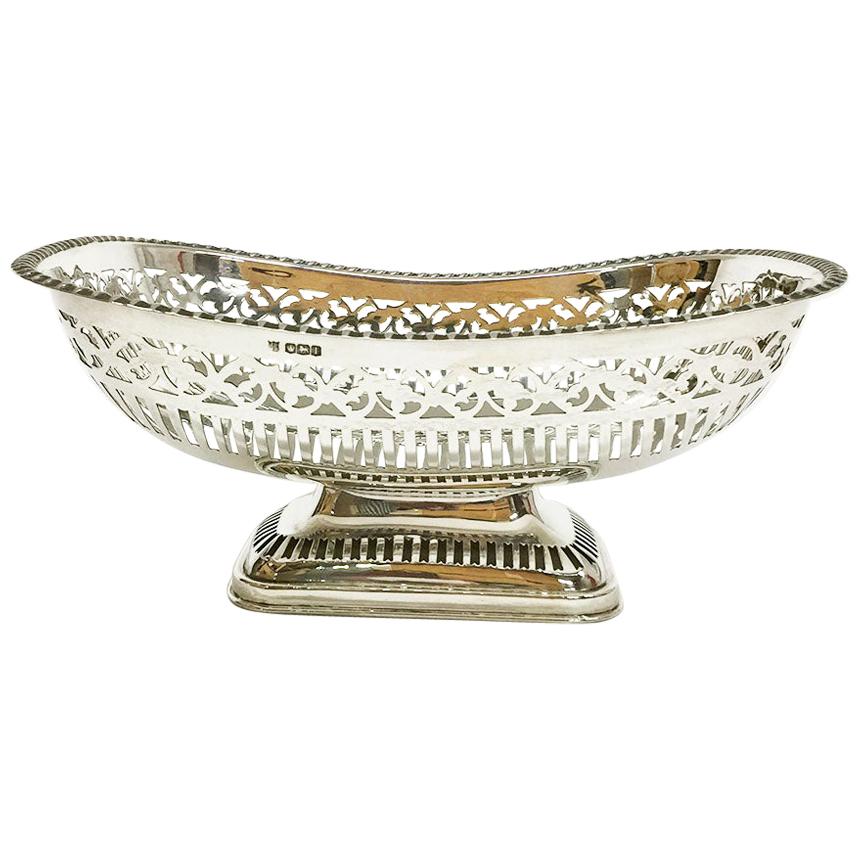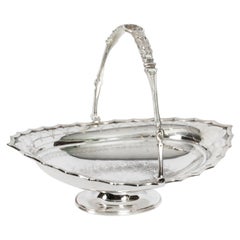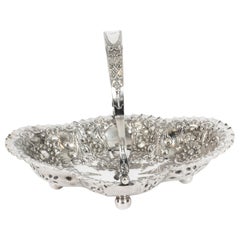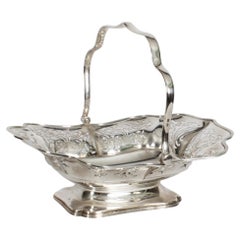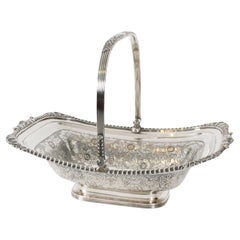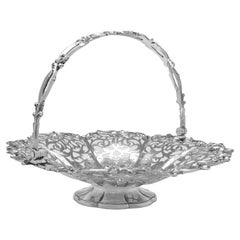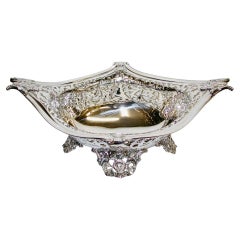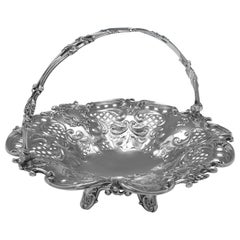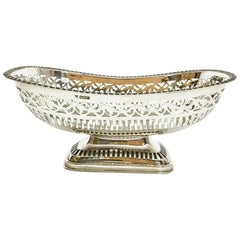Articles similaires à Antique Old Sheffield Plated Fruit Basket by Matthew Boulton 19th Century
Chargement de la vidéo
Vous voulez plus d'images ou de vidéos ?
Demander au vendeur plus d'images ou de vidéos
1 sur 16
Antique Old Sheffield Plated Fruit Basket by Matthew Boulton 19th Century
449,58 €
À propos de cet article
This is a stunning George III Old Sheffield Plate swing handled cake/fruit basket bearing the sunburst makers marks of the world renowned silversmith Matthew Boulton, circa 1820 in date.
The basket features a swing handle, is chased and engraved with flowers, scrolling stiff leaves and fruiting vine and has a wonderful engraved coat of arms in the centre.
The attention to detail is absolutely fantastic and it is certain to attract attention wherever it is placed.
Condition:
In excellent condition with clear makers marks and no dings, dents or signs of repair. Please see photos for confirmation.
Dimensions in cm:
Height 24 cm x Width 30 cm x Depth 30 cm
Dimensions in inches:
Height 9 inches x Width 1 foot x Depth 1 foot
Matthew Boulton
Boulton was not a "goldsmith" or a "silversmith" in the accepted sense, yet for his achievements and services to the craft of goldsmithing he is fully worthy of inclusion in the list of great English goldsmiths.
Matthew Boulton was born in Birmingham on 3 September 1728. His father Matthew Boulton (senior) was a "toy maker" and silver stamper specialized in the production of shoe-buckles.
Boulton junior was taken into partnership in 1749 and was left in sole charge of the business after the death of his father in 1759.
Boulton had the ambition to establish a manufacturing complex where craftsmen in the various branches of the "toy" trade would work together under one roof, enabling him to reap both wholesale and retail profits. In 1761 he realized his project purchasing a one-hundred- year-lease of the "Soho" estate at Handswoth Heath (two miles from Snow Hilton the Wolverhampton Road).
In 1762 Boulton took into unofficial partnership John Fothergill who would act as a travelling salesman to advertise his wares and the factory moved to Soho in the same year.
The partnership concentrated in the production of steel "toys" a little later on buttons and buckles made in a variety of substances, including , of course, silver. In 1762 Soho factory began to produce articles in "Sheffield" plate and one of the first to adopt "Sterling silver thread" edging which prevent to reveal the underlying copper.
Boulton soon became the largest manufacturer of "Sheffield plate" of the country expanding the business of Soho manufactory in the production of bijouterie, objects d'art and de virtue, in ormolu, pinchbeck and shell, and in clocks.
In 1765 Boulton began the manufacture of pieces in solid silver, being obliged to send every piece of plate to Chester to be marked (Chester was the nearest assay office, 72 miles away from Birmingham). Boulton was the promoter a petition obtaining in 1773 the Royal Assent to assay silver in Birmingham (the same was for Sheffield).
Boulton & Fothergill entered their joint mark consisting of their initials, MB before IF. After the death of Fothergill (1782) Boulton punched his plate with his initials alone.
When manufacturers of plated ware were permitted to register their marks at the Assay Office in Sheffield (1784), Boulton registered his mark of "twin suns" under the name Boulton M. & Co.
The most important designers for Boulton plate in the neo-classic taste were Robert Adams and James Wyatt.
Matthew Boulton died on 17 August 1809.
The mark MB continued to be used by Matthew Boulton Plate Co until 1832.
Old Sheffield Plate - or ‘fused plate’ as it is sometimes known, was the first commercially viable method of plating metal.
The material was accidentally invented by Thomas Boulsover, of Sheffield's Cutlers Company, in 1743. While trying to repair the handle of a customer's decorative knife, he heated it too much and the silver started to melt. When he examined the damaged handle, he noticed that the silver and copper had fused together very strongly. Experiments showed that the two metals behaved as one when he tried to reshape them, even though he could clearly see two different layers.
Boulsover set up in business, funded by Strelley Pegge of Beauchief, and carried out further experiments in which he put a thin sheet of silver on a thick ingot of copper and heated the two together to fuse them. When the composite block was hammered or rolled to make it thinner, the two metals were reduced in thickness at similar rates. Using this method, Boulsover was able to make sheets of metal which had a thin layer of silver on the top surface and a thick layer of copper underneath. When this new material was used to make buttons, they looked and behaved like silver buttons but were a fraction of the cost.
The technique Boulsover developed was to sandwich an ingot of copper between two plates of silver, tightly bind it with wire, heat it in a furnace and then mill it out in to sheet, from which objects could be made.
Our reference: A4520
- Dimensions:Hauteur : 24 cm (9,45 po)Largeur : 30 cm (11,82 po)Profondeur : 30 cm (11,82 po)
- Style:George III (Dans le style de)
- Matériaux et techniques:
- Lieu d'origine:
- Période:
- Date de fabrication:circa 1820
- État:
- Adresse du vendeur:London, GB
- Numéro de référence:Vendeur : A45201stDibs : LU950645390982
À propos du vendeur
5,0
Vendeur Platine
Vendeurs premium dont la note est supérieure à 4,7 et le délai de réponse de 24 heures maximum
Établi en 1983
Vendeur 1stDibs depuis 2012
1 398 ventes sur 1stDibs
Temps de réponse habituel : <1 heure
Associations
LAPADA - The Association of Arts & Antiques Dealers
- ExpéditionRecherche du devis...Expédition depuis : London, Royaume-Uni
- Politique des retours
Certaines parties de cette page ont été traduites automatiquement. 1stDibs ne garantit pas l'exactitude des traductions. L'anglais est la langue par défaut de ce site web.
Garantie d'authenticité
Bien qu'il soit peu probable que la situation se présente, dans le cas où vous rencontreriez un problème d'authenticité d'un article, contactez-nous dans un délai d'un an pour obtenir un remboursement intégral. DétailsGarantie de remboursement
Si votre article n'est pas conforme à la description, est endommagé pendant le transport ou ne vous est pas livré, contactez-nous sous 7 jours pour obtenir un remboursement intégral. DétailsAnnulation sous 24 heures
Vous disposez d'un délai de 24 heures pour annuler votre achat sans motif.Des vendeurs professionnels agréés
Nos vendeurs de renommée mondiale doivent respecter des normes strictes en matière de service et de qualité, afin de préserver l'intégrité de nos fiches produit.Garantie d'alignement des prix
Si vous constatez qu'un autre vendeur a mis en vente le même article à un prix inférieur sur un autre site, nous nous alignerons sur ce prix.Livraison en toute confiance à l'international
Notre réseau de transporteurs de premier ordre propose des options d'expédition spécialisées dans le monde entier, y compris des livraisons personnalisées.Plus d'articles de ce vendeur
Tout afficherPanier à fruits victorien ancien en métal argenté du 19ème siècle
Il s'agit d'une superbe corbeille à fruits victorienne ancienne en argent plaqué, datant d'environ 1860.
Le corps de forme ovale présente un fabuleux décor gravé de feuillages......
Catégorie
Antiquités, années 1860, Anglais, Victorien, Argenterie et Sheffield
Matériaux
Plaqué argent
Panier à fruits victorien ancien en métal argenté James Dixon 19ème siècle
Par James Dixon & Sons
Il s'agit d'une exceptionnelle corbeille à fruits en argent plaqué de l'époque victorienne anglaise, avec des poinçons du célèbre orfèvre James Dixon, datant d'environ 1880.
Ce m...
Catégorie
Antiquités, années 1880, Anglais, Victorien, Argenterie et Sheffield
Matériaux
Plaqué argent
Antique Anglais Edward VII Panier à pain à fruits en argent sterling Sheffield, 1907
Par Atkin Brothers
Il s'agit d'une corbeille à fruits en argent sterling de l'époque édouardienne, d'une qualité exceptionnelle, portant le poinçon de Sheffield 1907 et la marque de fabrique d'Atkins A...
Catégorie
Antiquités, Début des années 1900, Anglais, Édouardien, Argenterie et Sh...
Matériaux
Plaqué argent
Ancien panier George III en argent sur cuivre du 19ème siècle
Il s'agit d'une fabuleuse corbeille à pain / plat à fruits néo-classique de George III en argent et cuivre de Sheffield, datant d'environ 1810.
Le panier rectangulaire à anse pivota...
Catégorie
Antiquités, XIXe siècle, Anglais, Néoclassique, Vaisselle
Matériaux
Plaqué argent, Cuivre
Panier ancien George III de Sheffield en argent sur cuivre, 18ème siècle
Il s'agit d'une fabuleuse corbeille à pain / plat à fruits néo-classique de George III en argent et cuivre de Sheffield, datant d'environ 1780.
Le plat ovale à anse pivotante pré...
Catégorie
Antiquités, années 1780, Anglais, George III, Argenterie et Sheffield
Matériaux
Plaqué Sheffield
Soupière et couvercle en forme de dôme ancienne en plaque de Sheffield, 18ème siècle
Il s'agit d'une magnifique grande soupière anglaise ancienne en métal argenté Old Sheffield avec le couvercle bombé d'origine, datant d'environ 1790.
Il porte la marque des croisill...
Catégorie
Antiquités, années 1790, Anglais, Argenterie et Sheffield
Matériaux
Plaqué Sheffield
Suggestions
Panier à fruits en argent sterling du 19e siècle fabriqué à Londres en 1853
Par James & Nathaniel Creswick
Poinçonné à Londres en 1853 par James & Nathaniel Creswick, ce joli panier victorien en argent sterling ancien présente une bordure moulée, une décoration percée et gravée sur le cor...
Catégorie
Antiquités, années 1850, Anglais, Victorien, Paniers décoratifs
Matériaux
Argent sterling
Antique panier à fruits victorien daté de 1898 Londres William Hutton & Sons
Par William Hutton & Sons
Ancienne corbeille à fruits victorienne en argent datée 1898 London William Hutton & Sons Ltd
Fabuleuse corbeille qui peut être utilisée pour beaucoup d'autres choses que des fruits,...
Catégorie
Antiquités, années 1890, Anglais, Victorien, Argent sterling
Matériaux
Argent sterling
Panier victorien ancien en argent sterling en soie - Sheffield 1845 - Hawksworth Eyres
Poinçonné à Sheffield en 1845 par Hawksworth Eyres & Co, cet attrayant panier en argent sterling ancien est orné d'une conception, reposant sur des pieds en coquille moulée, et prése...
Catégorie
Antiquités, années 1840, Anglais, Victorien, Argent sterling
Matériaux
Argent sterling
Corbeille à fruits anglaise en argent sterling de James Deakin & Sons, 1928
Par James Deakin & Sons
Corbeille à fruits en argent sterling anglais par James Deakin & Sons, 1928
Corbeille à fruits rectangulaire en argent anglais sur une base.
Un panier en argent sterling de Sheffie...
Catégorie
Début du 20ème siècle, Britannique, Argent sterling
Matériaux
Argent
Panier à pain à fruits anglais victorien sur pied en métal argenté avec poignée
Antique L & WS English Victorian Silver Plated Footed Fruit Bread Basket with Handle. Circa Mid 20th Century.
Mesures : 3,5" H x 12" L x 9,5" P.
Catégorie
Milieu du XXe siècle, Victorien, Coupes décoratives
Matériaux
Plaqué argent
Panier à gâteaux anglais victorien Melvin Pratt de la fin du 19e siècle avec poignée
Panier à gâteau rond en argent Melvin Pratt d'époque victorienne anglaise, datant de la fin du XIXe siècle, avec un design ajouré et des motifs de feuillage. Créée en Angleterre par ...
Catégorie
Antiquités, XIXe siècle, Anglais, Victorien, Argenterie et Sheffield
Matériaux
Argent
